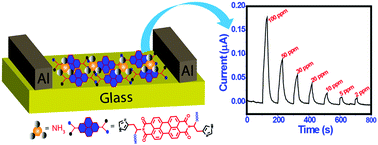Vapor phase sensing of ammonia at the sub-ppm level using a perylene diimide thin film device†
Abstract
The fabrication of a two terminal sensor device based on a histidine substituted perylene diimide (PDI-HIS) thin film for the sensitive detection and quantification of ammonia (NH3) vapors by monitoring the changes in its current intensity is reported at room temperature under ambient conditions. The thin film morphological variations of the drop cast PDI-HIS films before and after exposure to NH3 vapors are characterized by FESEM and TEM confirming the diffusion/adsorption of the NH3 vapors. The solution cast PDI-HIS thin film gas sensor device exhibited rapid, highly sensitive and selective vapor phase response towards NH3 with a detection limit as low as 0.56 ppm which is much lower than the maximum permissible limit set for NH3 (25 ppm) for prolonged exposure. Furthermore, control sensing experiments performed using alkyl substituted PDI (PDI-n-octyl) demonstrated that the presence of histidine groups at the imide position of PDI-HIS drastically affects the solid-state aggregation mode as well as redox potential that ultimately enhances the sensing response of the device. The key performance parameters of the device such as sensitivity, response/recovery time, selectivity, recyclability, stability and detection limit demonstrated the protocol as simple, reliable, cost-effective and most efficient in performing NH3 detection under very realistic conditions.


 Please wait while we load your content...
Please wait while we load your content...